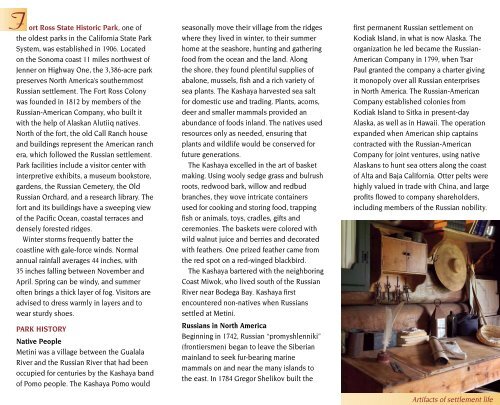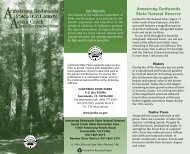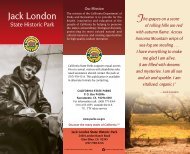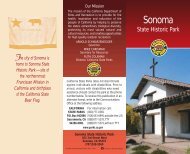Download the Official Fort Ross State Historic Park Map/Brochure
Download the Official Fort Ross State Historic Park Map/Brochure
Download the Official Fort Ross State Historic Park Map/Brochure
Create successful ePaper yourself
Turn your PDF publications into a flip-book with our unique Google optimized e-Paper software.
F ort <strong>Ross</strong> <strong>State</strong> <strong>Historic</strong> <strong>Park</strong>, one of<br />
<strong>the</strong> oldest parks in <strong>the</strong> California <strong>State</strong> <strong>Park</strong><br />
System, was established in 1906. Located<br />
on <strong>the</strong> Sonoma coast 11 miles northwest of<br />
Jenner on Highway One, <strong>the</strong> 3,386-acre park<br />
preserves North America’s sou<strong>the</strong>rnmost<br />
Russian settlement. The <strong>Fort</strong> <strong>Ross</strong> Colony<br />
was founded in 1812 by members of <strong>the</strong><br />
Russian-American Company, who built it<br />
with <strong>the</strong> help of Alaskan Alutiiq natives.<br />
North of <strong>the</strong> fort, <strong>the</strong> old Call Ranch house<br />
and buildings represent <strong>the</strong> American ranch<br />
era, which followed <strong>the</strong> Russian settlement.<br />
<strong>Park</strong> facilities include a visitor center with<br />
interpretive exhibits, a museum bookstore,<br />
gardens, <strong>the</strong> Russian Cemetery, <strong>the</strong> Old<br />
Russian Orchard, and a research library. The<br />
fort and its buildings have a sweeping view<br />
of <strong>the</strong> Pacific Ocean, coastal terraces and<br />
densely forested ridges.<br />
Winter storms frequently batter <strong>the</strong><br />
coastline with gale-force winds. Normal<br />
annual rainfall averages 44 inches, with<br />
35 inches falling between November and<br />
April. Spring can be windy, and summer<br />
often brings a thick layer of fog. Visitors are<br />
advised to dress warmly in layers and to<br />
wear sturdy shoes.<br />
PARK HISTORY<br />
Native People<br />
Metini was a village between <strong>the</strong> Gualala<br />
River and <strong>the</strong> Russian River that had been<br />
occupied for centuries by <strong>the</strong> Kashaya band<br />
of Pomo people. The Kashaya Pomo would<br />
seasonally move <strong>the</strong>ir village from <strong>the</strong> ridges<br />
where <strong>the</strong>y lived in winter, to <strong>the</strong>ir summer<br />
home at <strong>the</strong> seashore, hunting and ga<strong>the</strong>ring<br />
food from <strong>the</strong> ocean and <strong>the</strong> land. Along<br />
<strong>the</strong> shore, <strong>the</strong>y found plentiful supplies of<br />
abalone, mussels, fish and a rich variety of<br />
sea plants. The Kashaya harvested sea salt<br />
for domestic use and trading. Plants, acorns,<br />
deer and smaller mammals provided an<br />
abundance of foods inland. The natives used<br />
resources only as needed, ensuring that<br />
plants and wildlife would be conserved for<br />
future generations.<br />
The Kashaya excelled in <strong>the</strong> art of basket<br />
making. Using wooly sedge grass and bulrush<br />
roots, redwood bark, willow and redbud<br />
branches, <strong>the</strong>y wove intricate containers<br />
used for cooking and storing food, trapping<br />
fish or animals, toys, cradles, gifts and<br />
ceremonies. The baskets were colored with<br />
wild walnut juice and berries and decorated<br />
with fea<strong>the</strong>rs. One prized fea<strong>the</strong>r came from<br />
<strong>the</strong> red spot on a red-winged blackbird.<br />
The Kashaya bartered with <strong>the</strong> neighboring<br />
Coast Miwok, who lived south of <strong>the</strong> Russian<br />
River near Bodega Bay. Kashaya first<br />
encountered non-natives when Russians<br />
settled at Metini.<br />
Russians in North America<br />
Beginning in 1742, Russian “promyshlenniki”<br />
(frontiersmen) began to leave <strong>the</strong> Siberian<br />
mainland to seek fur-bearing marine<br />
mammals on and near <strong>the</strong> many islands to<br />
<strong>the</strong> east. In 1784 Gregor Shelikov built <strong>the</strong><br />
first permanent Russian settlement on<br />
Kodiak Island, in what is now Alaska. The<br />
organization he led became <strong>the</strong> Russian-<br />
American Company in 1799, when Tsar<br />
Paul granted <strong>the</strong> company a charter giving<br />
it monopoly over all Russian enterprises<br />
in North America. The Russian-American<br />
Company established colonies from<br />
Kodiak Island to Sitka in present-day<br />
Alaska, as well as in Hawaii. The operation<br />
expanded when American ship captains<br />
contracted with <strong>the</strong> Russian-American<br />
Company for joint ventures, using native<br />
Alaskans to hunt sea otters along <strong>the</strong> coast<br />
of Alta and Baja California. Otter pelts were<br />
highly valued in trade with China, and large<br />
profits flowed to company shareholders,<br />
including members of <strong>the</strong> Russian nobility.<br />
Artifacts of settlement life






